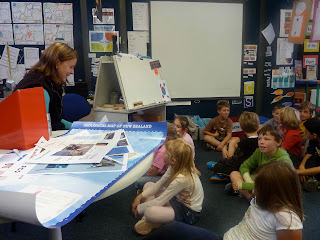EXPLORING A FICTIONAL WORKSPACE
Today was our first day of our
new Mantle of the Expert unit. We
began our work by exploring a space in the classroom that had a range of maps
(bathymetry and geological), a range of books on geology, a table of
interesting looking rocks (kindly lent to us to examine by a real geologist),
and some signs such as ‘Staff Board’, ‘GeoReady’, and ‘Equipment and Tool
Cupboard’. As we had a look around
we talked about what this space might represent. We shared our ideas and decided that it was a workspace for
people who study rocks (geologists) and work with maps (geographers). We decided that the sign ‘GeoReady’ was
the name of the company.
 |
| Exploring fictional workspace |
We then had some more discussion
in small groups to find out what we all knew already about ‘geology’. The knowledge we had between us is a
great starting point for our topic. As we talked about
what we already knew some good questions came up about the difference between
plate boundaries and faults, deep (geological) time, and land movement and
formation. Here are some inquiry
questions that arose today:
- What
is a fault line? Is it the
same as the place where two plates meet? Some of us think NZ has only 1 or maybe 2 faults.
- One rock we looked at had shells inside it. Some of
us described the shells as fossils and some talked about how “sand covered
the shells up and then turned slowly to stone”. But there was quite a discussion about how long this
would take – some ideas were ten thousand years or maybe a million years
or perhaps just 20 years?
- Is
the land always moving? Or
does it only move when there is a big land event like an earthquake?
- Is the study of rocks on other planets geology?
LOOKING AT ROCKS
We were lucky today to have some
real rocks to look at closely and describe. Here are some pictures of us looking at rocks and what we
thought about them. We are going to find out some more about these rocks later on in our work.
“ there are tiny diamonds,
crystals – diamonds are a type of crystal” Sandy
"it feels rough and sharp, and it is an interesting shape" Eliza and Esme
"it has sparkly green and small blackish bits" Alana
"maybe it came from a waterfall in New Zealand" Alana, Eliza, and Esme
"it is black and sparkly their might be diamonds in it"Sam McR, Ethan, and Baxter
"it might be from a mine" Sam McR, Ethan, and Baxter
"this rock sparkles, it has a couple of small ditches at the top" Millie, Holly, and Lucy
"this rock looks like plastic and clay" Sophia
"it feels sandy, it is oval, smooth" Henry, Seb, and Finn
"it looks like 2 rocks joined together" Sam B and Sam R
"it looks like a poached egg. It has crystal stuff inside. It feels smooth on top and bumpy on the bottom. You can see yellowish stuff when you hold it up to the light and it is sort of see through, it is amazing" Kahu and Finn
GEONET BLOG
We also visited the GeoNet blog
(link on side of this page) and read about some of the work they do. We then came up with some questions for
Sara who works at GeoNet and is coming to visit us to help us with our inquiry
work next week.
We then drew some tools for our
equipment cupboard using information we found on the GeoNet blog (shovels, bags
of concrete, seismic monitors, data cards, buckets, torches….)
 |
| Our Equipment Toolshed |
WRITING A MISSION STATEMENT
Our final activity today was wording some mission statements
for our company GeoReady. We had
to think carefully about the words we chose so they were clear, effective, and
catchy! Here are the statements
that made it to the final vote, the first two statements were our winners! (to
be seen on letterheads, staff ID cards, and company signs in the near future).
Geo Ready: When the earth is
going crazy we are the experts. (Alana, Oscar, and Kahu)
Geo Ready: Geological Hazard Watch - we’ve got our eye on
you! (Lachlan)
Geo Ready: We monitor the nation
(Luke)
We are ready for geological hazards (Seb)
Geo Ready is ready for action
(Sophia)
We help with geological hazards (Eliza)














